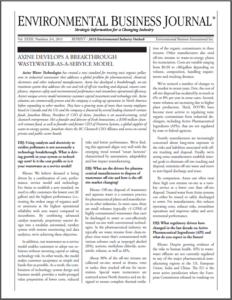
Axine Water Technologies has created a new standard for treating toxic organic pollutants in industrial wastewater that addresses a global problem for pharmaceutical, chemical, electronics and other industrial manufacturers. Axine has developed a breakthrough, on-site treatment system that addresses the cost and risk of off-site trucking and disposal, ensures compliance, improves safety and environmental performance and streamlines operational efficiency. Axine’s unique service model minimizes customer capital investment and technology risk. Axine solutions are commercially proven and we’re scaling-up operations in North America before expanding to other markets. They have a growing team of more than twenty employees based in Canada and the US; and the company is financed by several leading cleantech venture funds. Jonathan Rhone, President & CEO of Axine. Jonathan is an award-winning, serial cleantech entrepreneur. He’s a founder and director of Evok Innovations, a $100 million cleantech venture fund, as well as founder and former CEO of Nexterra Systems, a global supplier of waste-to-energy systems. Jonathan chairs the BC Cleantech CEO Alliance and serves on several private and public sector boards.
EBJ: Using catalysts and electricity to oxidize pollutants is not necessarily a technology breakthrough. What is driving growth in your system or technology now? Is it the cost profile or is it your wastewater as a service model?
Rhone: We believe demand is being driven by a combination of cost, performance, service model and technology. For Axine to establish a new standard, we need to offer customers the lowest cost ($/gallon) and the highest performance (i.e., treating the widest range of organics and/or ammonia at the highest operational reliability with zero waste) compared to incumbents. By combining advanced catalyst materials, proprietary reactor design into a modular, automated, turnkey system with remote monitoring and data analytics, we’re achieving these objectives.
In addition, our wastewater-as-a-service model enables customers to adopt our solutions without investing capital or taking technology risk. In other words, the model makes customer acceptance as simple and hassle-free as possible. As a result, the combination of technology, system design and business model, provides a multi-pronged value proposition of lower costs, reduced risks and better performance. We’re finding this approach aligns very well with the emerging trend toward “smart factories” characterized by automation, adaptability and low impact manufacturing.
EBJ: What are the drivers for pharmaceutical manufacturers to dispose of wastewater off-site and how is the off-site market changing?

Rhone: Off-site disposal of wastewater and aqueous waste is a common practice for pharmaceutical plants and manufacturers in other industries. In most cases, these are small volumes (typically <5 GPM) of highly contaminated wastewater that can’t be discharged to sewer or cost-effectively treated on-site with conventional technologies. In the pharmaceutical industry, we typically see waste streams from clean-in-place rinse water that’s contaminated with various solvents such as isopropyl alcohol (IPA), acetone, methylene chloride, acetonitrile, toluene, as well as APIs.
About 90% of the off-site streams are collected on-site; stored in drums, totes or tanks; then trucked off-site for incineration. Special waste incinerators are scattered across North America and are designed to ensure complete thermal oxidation of the organic contaminants in these streams. Other manufacturers also send off-site streams to waste-to-energy plants for incineration. Costs are variable ranging from $0.30 to >$6/gallon depending on volume, composition, handling requirements and trucking distance.
We’ve noticed a number of changes to the market in recent years. First, the cost of off-site disposal has escalated by as much as 6% or 8% per year in some cases. Second, waste volumes are increasing due to higher plant production. Third, POTWs have become more activist in regulating toxic organic contaminant from industrial dischargers, including Active Pharmaceutical Ingredients (APIs), that are not regulated by state or federal agencies.
Fourth, manufacturers are increasingly concerned about long-term exposure to the risks and liabilities associated with off-site trucking and disposal. Finally, we’re seeing some manufacturers establish internal goals to eliminate off-site trucking and disposal, minimize off-site waste and move to zero liquid discharge and reuse.
By comparison, Axine can often treat these high cost streams on-site as a turnkey service at a lower cost than off-site disposal. Treated water from Axine systems can either be reused or safely discharged to sewer. For manufacturers, this reduces operating costs, reduces risks, streamlines operations and improves safety and environmental performance.
EBJ: What regulatory drivers have changed in the last decade on Active Pharmaceutical Ingredients (API) and what do you expect in the future?
Rhone: Despite growing evidence of the risks to human health, APIs in wastewater effluent are not currently regulated in any of the major pharmaceutical manufacturing regions in the US, European Union, India and China. The EU is the most active jurisdiction where the European Commission released its roadmap on pharmaceuticals and the environment in 2017 and completed public consultation in 2018. Regulatory progress, however, has been slow due to a number of factors including the complexity of regulating over 3,000 types of APIs manufactured in different countries with different (and in many cases unknown) risks to the environment and human health. Nevertheless, it’s become increasingly clear from the World Economic Forum, WHO and others that APIs represent a significant global threat to human health. In particular, antibiotic APIs have created antibiotic resistant strains of bacteria which cause hundreds of thousands of deaths per year. It’s also become clear that manufacturing effluent is a more significant contributor to API contamination of surface waters than previously understood.
In the absence of API regulations, we’re seeing the emergence of industry-led organizations such as the Pharmaceutical Supply Chain Initiative, which is made up of major pharmaceutical companies specifically to establish and promote responsible practices to improve social, health, safety and environmentally sustainable outcomes within the pharmaceutical supply chain; and the AMR Industry Alliance, which is a private sector coalition of over 100 biotech and pharmaceutical companies set up to develop solutions to antimicrobial resistance.
We’re also finding a number of leading API manufacturers who are taking concrete steps to address API risks in their own operations, including treating APIs in manufacturing effluent. At Axine, we’re actively working with several large pharmaceutical companies to validate the cost and performance of our technology for projects at their manufacturing sites. Over the medium-term we expect the EU to continue to lead in developing API regulations under pressure from individual governments such as Sweden, NGOs and other stakeholders. However, we expect regulatory progress to be slow, unless there is a significant health “event” such as a superbug outbreak that motivates governments to act.
EBJ: When you talk about “emerging discharge standards,” do you think customers are in the habit of responding to the likelihood of future regulations? Or do you believe the demand is related to protecting their corporate reputation or avoidance of future liabilities?
Rhone: It’s hard to say exactly, but we believe customers are primarily motivated to mitigate future liabilities and secondarily to protect corporate reputations. As described above, regulations will eventually be adopted but they’ve been slow to materialize, complex to design and subject to political interference. In the meantime, we believe industry leaders will act based on the sheer scale of the global risk to human health and the fact that the causes could be traced back to manufacturing operations, practices and product use.
EBJ: What is the typical or representative capital expenditure for one of your systems at various scales and what are typical operating costs?
Rhone: Capital and operating costs are variable depending on wastewater flow rates, influent composition and treatment requirements. Under our service agreements, customers don’t pay for capital or operating costs. Axine finances, designs, builds, installs, operates, monitors and maintains the systems. Customers receive performance reports and pay a fixed monthly service fee. Depending on the size of the project, annual service fees can range from less than $100,000 per year to over $1,000,000 per year.
EBJ: What percentage of your customers are on the wastewater as a service model?
Rhone: 100% of our customers are operating under service agreements. In fact, we don’t offer customers the option to purchase our systems. We decided early on that a service model would be the best approach to accelerate customer adoption by eliminating technology risk and minimizing customer capital spending. This allows us to go to customers and say “we’ve evaluated your wastewater stream(s) and you’re spending $XX/year for off-site trucking and disposal. We can treat that stream(s) on-site for 20%, 30% or 40% less than what you are paying today. At the same time, we can eliminate off-site trucking and disposal risks, streamline and automate operations, minimize waste, lower greenhouse gas emissions….and you don’t have to spend any capital, operate or maintain equipment or take any technology risk.” This is a very attractive option for many customers and the market response has been extremely positive.
EBJ: APIs were once an emphasis of wastewater treatment and seen as the emerging threat. Today, the emerging contaminants getting all the attention are PFAS from firefighting foam, Teflon and other sources. Can electro chemical oxidation work on these emerging contaminants or does the company have a plan or solution to apply to that market?
Rhone: Certainly, PFAs and the other chemicals are getting a lot of attention and we have recently had inquiries about the potential for Axine solutions to address these pollutants. There’s no question that our technology can oxidize these organic pollutants. The open question is whether these are viable markets for Axine where we can achieve adoption and scale. Over the long-term our aspiration is to become the global standard for treating toxic organics in industrial wastewater. At this stage, however, it important for us to stay laser focused on a few target markets where we can achieve speed of adoption and a network of successful deployments to drive replication.
EBJ: What other technologies for commercial operations and market sectors does Axine have or target?
Rhone: We’ve initially focused on the pharmaceutical and electronics markets. We’re now expanding into the chemical industry, targeting niche markets such as crop protection, coatings and other specialty chemicals. Going forward, we see opportunities for our solutions in oil refineries, waste management (e.g., landfill leachate), automobile manufacturing and other heavy industries. We’re also evaluating how to integrate complimentary technologies into our systems to expand markets served. For example, membrane technologies may enable us to concentrate organics to more efficiently treat wastewater with very low concentrations of organics.
EBJ: What is Axine’s ownership structure, investment history and future of the company?
Rhone: Axine is a privately-held company owned by employees and a syndicate of leading cleantech venture funds. The company has raised approximately $14M in equity from investors that include Chrysalix Venture Capital, BDC Venture Capital, The Roda Group and Asahi Kasei Ventures. We’ve also received significant non-dilutive funding support from Canadian government agencies such as Sustainable Development Technology Canada, the National Research Council of Canada, and Western Economic Development. Future plans include scaling-up US operations in 2019 and expanding into international markets in 2020.
This reprint was excerpted from an article published in the “2019 Environmental Industry Outlook” edition of EBJ and reprinted with permission from Environmental Business International Inc. All rights reserved. © 2019 EBI Inc., www.ebionline.org

